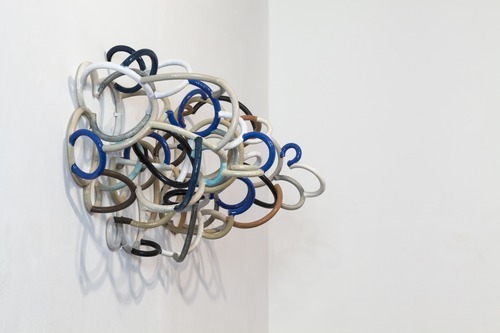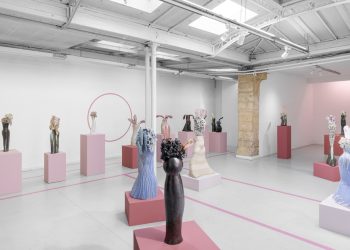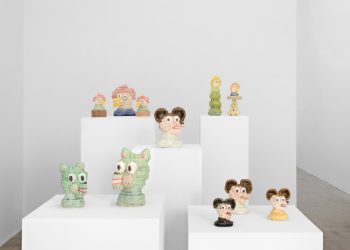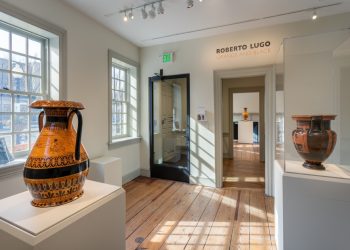
Nicola Tassie: Craft / Standpoint Gallery, London
September 19 – October 26, 2014
This exhibition marks a point of reckoning in the oeuvre of Nicola Tassie, one of London’s most sought-after studio ceramicists and teachers. Drawing on three decades of experimentation, consolidation and reflection, this exhibition pushes newly-made and older works up against one another. The installations and displays of functional, functionally ambiguous, and overtly sculptural works show Tassie investigating with renewed clarity the questions she has posed and re-posed in regard to the practice and reception of ceramics throughout her career.
The exhibition provides a timely opportunity for the audience who know Tassie’s tableware (via regular display at Margaret Howell, The New Craftsmen and The Wills Lane Gallery amongst others) to engage with the scope and depth of her personal investigation into the materiality and conflicted signification of ceramics.
Tassie is a purist only in her insistence that ceramic is the sole material, and that is integral to the meaning of every piece. Her inventions and juxtapositions open up questions that are normally kept under the radar, yet arguably remain core to the contested distinction between craft and art within ceramic practice: how does a traditional glossy glaze function and signify when adorning an abstract sculpture? What does the punctuation mark of a synthetic glazed, bright blue jug bring to a shelf of muted ‘studio pottery’ ash glaze work?
Central to the design of Craft will be a floor-to-ceiling tower of glass display shelves packed with ceramic objects of disparate finishes and genres. Tassie’s signature conical jugs occupy just one shelf. A high shelf is densely peopled with a range of squashed and sagging, unfired ‘bottles’, whose tops – being coextensive with the body of the vessel – render them unusable. They are abject and emotive, redolent of sorrow, neediness, or feelings of failure. Lower down in the ‘hierarchy’, a range of ambiguous shapes and objects that look faux-functional are indeed ceramic renderings of the everyday tools of Tassie’s trade: a sponge, spindle, bowl of water. The installation echoes Tassie’s beloved V&A displays, while upsetting and querying the hierarchies and taxonomies that have dogged ceramic production. To engage with the history of tableware is to engage with taste and social class – we envy the translucency of the porcelain, the ostentation of the lusterware, the finesse of the painted decoration, and more recently fetishise the rough brown hew of a kitchen pot.
Trained as a painter at Central School of Art and Design in the early 80s, Tassie still turns to painting for many of her references. The work of American heavyweight-lightweight Phillip Guston has been a constant inspiration, seen most overtly here in ceramic ‘light bulbs’ and a ceramic ‘shaft of light’ in her new ‘lamp’ pieces, and in the joyfully cartoonish line she employs in a experimental new wall piece, which uses arcs of extruded paper clay to make a gravity-defying drawing in space.
In Table-Top, a group of ostensibly traditional, functional vessels are vigorously cross-hatched in a centrifugal design that confounds and ignores the edges of the individual objects to describe a middle zone of darkness when the viewer is stationed at the correct perspectival point. This play between two and three dimensions suggests conflicting levels or hierarchies of reality existing concurrently – the drawing becomes a floating, semi-spherical haze – a kind of haunting, of the objects onto which it is scratched.
For the horizontal group Modern Midnight Conversations Tassie borrows the title of a Hogarth painting from circa 1730, which depicts a Georgian drinking party in full swing. Here we meet a second spread of bottles, found in various states of reclining or sagging indisposition. These are also sealed vessels, and are, as Tassie pithily states, “drunk on their own contents”. The trapped contents in question are meaning and emotion, those embarrassing / confessional qualities, released under the influence of alcohol, which are meant to be stripped from contemporary craft practice, but which cling. Within Tassie’s tipped-up hierarchies, these eternal human preoccupations and drives can covertly try out on centre-stage.
Gallery hours: Wednesday – Saturday, 12-6 pm.
Contact
E: standpointgallery@btconnect.com
T: 0207 739 4921
Standpoint Gallery
45 Coronet Street
London N1 6HD
United Kingdom
Above: Nicola Tassie, Arc, 2014, Stoneware, glaze, 120 x 60 x 50 cm. Photo by Peter Abrahams.
More exhibitions | View the list of ceramic art exhibitions




















